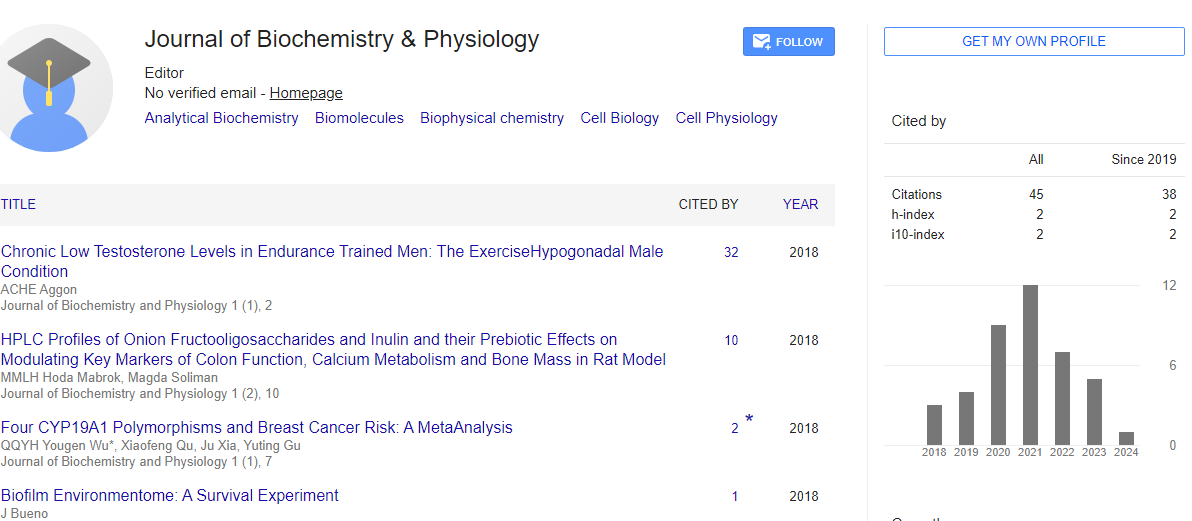Perspective, J Biochem Physiol Vol: 7 Issue: 1
Enzymes as Molecular Tools: Techniques and Applications in Research and Diagnostics
Tate Yang*
1Department of Biomedical Engineering, Chongqing University, Chongqing, China
*Corresponding Author: Tate Yang,
Department of Biomedical Engineering,
Chongqing University, Chongqing, China
E-mail: yangta@te.cn
Received date: 19 February, 2024, Manuscript No. JBPY-24-134953;
Editor assigned date: 21 February, 2024, PreQC No. JBPY-24-134953 (PQ);
Reviewed date: 11 March, 2024, QC No. JBPY-24-134953;
Revised date: 20 March, 2024, Manuscript No. JBPY-24-134953 (R);
Published date: 29 March, 2024, DOI: 10.4172/jbpy.1000151.
Citation: Yang T (2024) Enzymes as Molecular Tools: Techniques and Applications in Research and Diagnostics. J Biochem Physiol 7:1.
Description
Enzymes play indispensable roles as molecular tools in various fields of science, including research and diagnostics. Their versatility, specificity, and efficiency make them invaluable for manipulating and analyzing nucleic acids, proteins, and other biomolecules. This article explores the diverse techniques and applications of enzymes in molecular biology research and diagnostic assays, highlighting their importance in advancing scientific knowledge and improving disease detection and monitoring.
Enzymes play crucial roles in nucleic acid manipulation techniques, facilitating DNA amplification, cloning, sequencing, and modification. Polymerase Chain Reaction (PCR), a cornerstone technique in molecular biology, relies on DNA polymerases to amplify specific DNA sequences through repeated cycles of denaturation, annealing, and extension. DNA ligases are used to join DNA fragments in cloning and gene editing applications, while restriction endonucleases cleave DNA at specific recognition sequences, enabling DNA fragment analysis and manipulation.
Enzyme-based DNA sequencing techniques, such as Sanger sequencing and Next-Generation Sequencing (NGS), have revolutionized genomics research and diagnostics. Sanger sequencing relies on DNA polymerases, Dideoxynucleotides (ddNTPs), and fluorescently labeled primers to generate DNA fragments of varying lengths, which are separated by capillary electrophoresis to determine the DNA sequence. NGS technologies, powered by DNA polymerases and other enzymes, enable high-throughput sequencing of DNA and RNA molecules, providing insights into genome structure, function, and variation.
Enzyme-Linked Immunosorbent Assay (ELISA) is a widely used diagnostic technique for detecting and quantifying proteins in biological samples. In ELISA, enzymes such as Horseradish Peroxidase (HRP) or Alkaline Phosphatase (AP) are conjugated to antibodies specific to the target protein of interest. Upon binding of the target protein to the immobilized antibody, the enzyme-linked secondary antibody catalyzes a colorimetric or chemiluminescent reaction, allowing for sensitive and specific protein detection in clinical samples.
Enzyme-based immunoassays, including Enzyme-Linked Immunosorbent Assay (ELISA), Enzyme-Linked Immunospot Assay (ELISPOT), and Enzyme Immunoassay (EIA), are powerful tools for detecting and quantifying antibodies, antigens, and other immunerelated molecules. These assays rely on the specific binding of antibodies to their target antigens, followed by enzymatic amplification and detection of the immune complex. Enzyme labels such as HRP, AP, and β-galactosidase enable signal amplification and visualization, allowing for sensitive and quantitative detection of immune responses in research and clinical settings.
Enzyme-based biosensors are analytical devices that utilize enzymes as recognition elements to detect specific analytes in complex biological samples. These biosensors often incorporate immobilized enzymes, such as oxidases, dehydrogenases, or hydrolases, which catalyze reactions that produce measurable signals, such as changes in pH, color, or fluorescence. Enzyme-based biosensors have diverse applications in medical diagnostics, environmental monitoring, and food safety testing, offering rapid, sensitive, and cost-effective detection of target analytes.
Enzyme amplification strategies, such as Rolling Circle Amplification (RCA) and Loop-Mediated Isothermal Amplification (LAMP), harness the catalytic activity of enzymes to amplify nucleic acid sequences under isothermal conditions. RCA utilizes DNA polymerases to repeatedly copy circular DNA templates, generating long single-stranded DNA concatemers that can be detected using complementary probes. LAMP, driven by DNA polymerases and strand-displacing enzymes, amplifies target DNA sequences with high specificity and efficiency, making it suitable for point-of-care diagnostics and field applications.
Enzyme-based therapeutics, including recombinant enzymes, Enzyme Replacement Therapies (ERT), and enzyme inhibitors, have revolutionized the treatment of various diseases, including enzyme deficiencies, metabolic disorders, and cancer. Recombinant enzymes, produced through biotechnology, offer targeted therapies for enzyme deficiencies by replacing or augmenting the activity of defective enzymes. ERT involves administering exogenous enzymes to patients with enzyme deficiencies, restoring normal physiological function and alleviating symptoms. Enzyme inhibitors, on the other hand, selectively target disease-associated enzymes, offering potential treatments for cancer, infectious diseases, and other disorders.
Conclusion
Enzymes serve as indispensable molecular tools in research and diagnostics, enabling a wide range of techniques and applications in molecular biology, clinical chemistry, and medical diagnostics. From nucleic acid manipulation and sequencing to protein detection and therapeutic interventions, enzymes play pivotal roles in advancing scientific knowledge and improving human health. Continued innovation and development of enzyme-based technologies hold promise for addressing current challenges in disease diagnosis, treatment, and monitoring, paving the way for future breakthroughs in biotechnology and medicine.
 Spanish
Spanish  Chinese
Chinese  Russian
Russian  German
German  French
French  Japanese
Japanese  Portuguese
Portuguese  Hindi
Hindi 